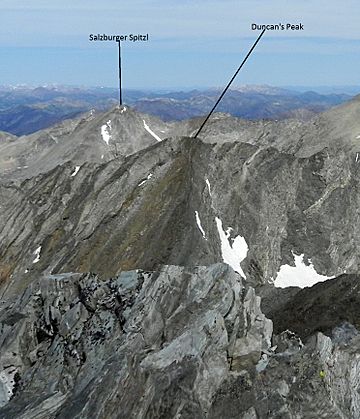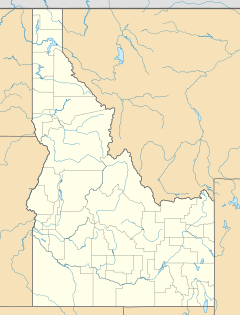Duncan's Peak facts for kids
Quick facts for kids Duncan's Peak |
|
|---|---|

Duncan's Peak viewed from Hyndman Peak
|
|
| Highest point | |
| Elevation | 11,755 ft (3,583 m) |
| Prominence | 395 ft (120 m) |
| Geography | |
| Parent range | Pioneer Mountains |
| Topo map | USGS Phi Kappa Mountain |
| Climbing | |
| Easiest route | Scramble, class 3 |
Duncan's Peak is a tall mountain in the U.S. state of Idaho. It stands at 11,755 feet (about 3,583 meters) above sea level. This makes it the ninth-highest peak in the Pioneer Mountains. It is also the 28th-highest peak in all of Idaho!
This mountain is located on the border of two counties: Blaine and Custer. It also sits between two large protected areas: the Sawtooth National Forest and the Salmon-Challis National Forest. Duncan's Peak is about 0.6 miles (1 kilometer) northwest of Hyndman Peak, another well-known mountain.
Contents
Exploring Duncan's Peak
Duncan's Peak is a part of the beautiful Pioneer Mountains. These mountains are known for their rugged beauty. They offer amazing views and outdoor adventures.
How High Is It?
Duncan's Peak reaches an elevation of 11,755 feet. This means it's nearly 2.2 miles straight up from sea level! Its height makes it a significant landmark in the region. It's a challenge for climbers and a sight to behold for everyone else.
Where Is Duncan's Peak Located?
This peak is found in central Idaho. It sits right on the line between Blaine and Custer counties. These counties are in the heart of Idaho's stunning natural landscapes. Being on the edge of two national forests means it's surrounded by protected wilderness.
National Forests Around the Peak
- Sawtooth National Forest: This forest is famous for its jagged peaks and clear lakes. It offers many trails for hiking and exploring.
- Salmon-Challis National Forest: This is one of the largest national forests in the U.S. It has vast wilderness areas and diverse wildlife.
Climbing Duncan's Peak
The easiest way to reach the top of Duncan's Peak is by a route called a "scramble." Scrambling is like a mix of hiking and easy rock climbing. It often involves using your hands to help you balance and move up steep sections. The difficulty is rated as class 3, which means it's a bit more challenging than a regular hike but doesn't usually require ropes.


